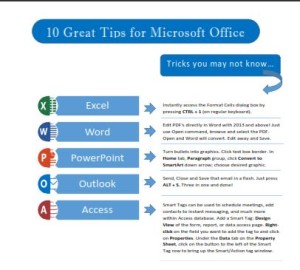Organize with OneNote
If you’re not using OneNote to capture notes, pictures, web clippings, audio and video, and just plain organize all types of information, you might want to give it a look. Free is a great draw, especially when it applies to a valuable tool that just might save your sanity.
Here’s Why You Want to Organize with OneNote:
- Available free on all platforms and devices.
- Create your own notebooks and color coded categories and reorganize with drag and drop.

- Type or insert text, audio, images, video anywhere on a page.
- Grab web pages or screen portions with Web Clipper from any browser.
- Insert PDF’s or file attachments.
- Format with MS Word built-in Styles for headings.
- Automatic date and time stamps for all entries.
- Share or link Notebooks, and export Sections or Pages and password protect Sections of a Notebook.
- Touchscreen and stylus friendly.
- Auto save and sync across all devices.
These are just a few of the features in OneNote. You can even insert equations; no need to find a calculator or fire up Excel at that meeting!
The Many Versions of OneNote
There are several varieties of OneNote and they are all free, including the full, desktop version. You can download it from Microsoft and, of course, it is included in the Office Apps available from any Microsoft account. Also, if you have purchased any version of Office, it is part of that suite. A subscription to Office 365 has it and will have automatically been upgraded to the latest version (currently 2016).
OneNote is available for all platforms and devices and the mobile app is integrated with Windows 10. It is designed for use with touch screens, tablets and phones but you can also download the full desktop version for free at www.onenote.com. Notebooks created in the app version automatically save to OneDrive, not to your computer. Those created in the desktop version can be saved anywhere. There are differences in the features of the two so you might want to test and see which one suits your needs and use it if you don’t want to be switching back and forth. Keep in mind that the online app does not have all the features of the Desktop version.
Not Your Daddy’s Notebook
OneNote’s structure is a digital version of the traditional multi-tabbed binder but before you stifle a yawn, it is no boring note-taking or storage device although it does both extremely well. Arrangement is divided into three levels and is organized much like the file and folder hierarchy you are used to on the computer. Allows for flexibility of organizing your way:
Top level: Notebooks. The big overall subject. You can create as many as you want and assign different colors. Keep it simple with one or two, or go crazy and create a gaggle. You control it. The list of created Notebooks displays at left.
Second level: Sections. Sub-categories. Are also color-categorized. These display as tabs on the top bar in the current Notebook..
Third level: Pages. Individual pages that display within the Section. The page names display at right.
Make OneNote Fantastic with OneTastic
Really make OneNote pop with this free Add-in to OneNote 2010 and above Desktop versions. This was a garage project by a Microsoft employee who used his bus time to create these great extra features to expand on OneNote’s already ample offerings.
You can create a monthly calendar of all your notes; resize and crop images and create a Table of Contents for a notebook, to name a few. If you want a sampling of what it can do, scope out this video:
https://www.youtube.com/watch?v=Rveq0S9mFH0.
If you like what you see and want to download Onetastic, go here: Download at website: https://getonetastic.com/
Evernote into OneNote
If you are an Evernote user and want to try out OneNote, Microsoft has an app for that! You can import your Evernote entries into OneNote here:
https://www.onenote.com/import-evernote-to-onenote
Most of us are always looking for a better and faster way to organize so let me know how OneNote is working for you!




























 Click to download great tips to speed up your Office projects.
Click to download great tips to speed up your Office projects.